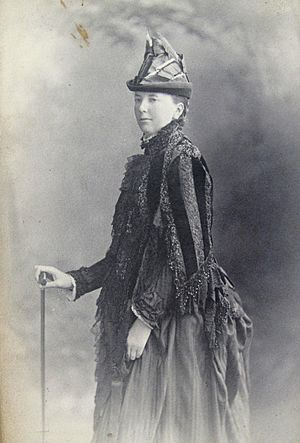Emily Lawless facts for kids
Quick facts for kids
Emily Lawless
|
|
|---|---|

Photographic portrait, date unknown
|
|
| Born | 17 June 1845 Lyons Demesne
|
| Died | 19 October 1913 Gomshall, Surrey
|
| Occupation | Writer |
The Hon. Emily Lawless (June 17, 1845 – October 19, 1913) was a talented Irish novelist, historian, entomologist (someone who studies insects), gardener, and poet. She was from County Kildare, Ireland. Emily was known for her new ways of telling stories and for creating characters with deep feelings. Her writing is seen as an early example of modern literature.
Contents
About Emily Lawless
Emily was born at Lyons House in County Kildare. She spent some of her childhood with her mother's family in County Galway. These experiences in the west of Ireland inspired many of her stories.
Her Family and Early Life
Emily's grandfather, Valentine Lawless, was part of a group called the United Irishmen. Her father was Edward Lawless, the 3rd Baron Cloncurry. This gave Emily the special title of "The Honourable."
When Emily was a girl, her father passed away. This caused money problems for her family. Because she was a woman, she did not have easy access to family money. So, she had to earn her own income by writing and selling her books.
Emily had five brothers and three sisters. Her brother Edward, who took over the family home, had strong political views. He was a landowner who supported keeping Ireland as part of the United Kingdom. He was also against the Land League, a group that worked for the rights of farmers. Emily did not always get along with her brother Edward.
Her Views and Writing Style
Emily Lawless was a strong supporter of Ireland remaining part of the United Kingdom. However, she also loved Ireland deeply and called herself an "Irish patriot." She wrote novels about everyday Irish people, including farmers. She showed understanding for both Irish landowners and the local people.
Some people, like the famous poet W.B. Yeats, criticized her work. They felt she did not always show Irish farmers in a fair way. This criticism later made her work less known for a while.
Emily also wrote about women's independence, especially in terms of money and creativity. She was a popular writer in the "New Woman" movement of the late 1800s. This movement encouraged women to be more independent and have more choices in life.
Emily Lawless passed away in Gomshall, Surrey, England. Sometimes, she used the pen name "Edith Lytton" for her writings. Some of her old papers and writings are kept at Marsh's Library in Dublin, Ireland.
Emily Lawless's Books
Emily Lawless wrote nineteen books, including novels, biographies, history books, nature studies, and poetry. Many of her books were very popular when they were first published. Today, she is seen as an important writer from the late 1800s and an early innovator in modern writing. She is often remembered for her poems called Wild Geese (1902).
Here are some of her books:
- A Chelsea Householder (1882)
- A Millionaire's Cousin (1885)
- Ireland (1885)
- Hurrish (1886)
- Major Lawrence FLS (1887)
- With Essex in Ireland (1890)
- Grania (1892)
- Maelcho (1894)
- Plain Frances Mowbray and Other Tales (1889)
- A Colonel of the Empire (1895)
- Traits and Confidences (1898)
- Atlantic Rhymes & Rhythms (1898)
- A Garden Diary (1901)
- With The Wild Geese (1902)
- Maria Edgeworth (1904)
- Book of Gilly (1906)
- The Point of View (1909)
- The Race of Castlebar (1914) - written with Shan Bullock
- The Inalienable Heritage (1914)
Her Novel Hurrish
Hurrish was Emily's fourth book. It tells a story about the Land War in County Clare, Ireland. This book was even read by William Ewart Gladstone, who was the Prime Minister of the United Kingdom. Some say it influenced his ideas about Ireland. The story is about Irish people's feelings against English law. In the book, a landlord is killed, and the main character's mother refuses to name the killer.
Some Irish newspapers did not like Hurrish. They said it had too much violence and that the characters were not very interesting. They also felt that Emily looked down on the Irish farmers she wrote about.
W.B. Yeats also criticized Hurrish, saying Emily did not fully understand the "Celtic nature" of the Irish people. However, Yeats still included two of her other books, With Essex in Ireland and Maelcho, in his list of the best Irish novels.
With Essex in Ireland and Grania
Emily's historical novel With Essex in Ireland was better received. It was ahead of its time because it used a technique called an "unreliable narrator." This means the person telling the story might not be telling the whole truth or might have a biased view. Prime Minister Gladstone even thought it was a real historical document from the Elizabethan era!
Her seventh book, Grania, was about a unique girl living on an Aran Island. The story explored the challenges girls and women faced in that fishing community.
Her Poems With the Wild Geese
Even though Emily was a strong supporter of the United Kingdom, her poems called Wild Geese (1902) became very popular. They were often quoted by Irish nationalists, who wanted Ireland to be independent.
One famous part from her poem "Clare Coast" goes:
- War-battered dogs are we,
- Fighters in every clime;
- Fillers of trench and of grave,
- Mockers bemocked by time.
- War-dogs hungry and grey,
- Gnawing a naked bone,
- Fighters in every clime
- Every cause but our own
Two of her poems, "Clare Coast" and "After Aughrim," were even included in The Oxford Book of Irish Verse in 1958.
Emily Lawless's Legacy
Emily Lawless's writings and papers are kept safe in Marsh's Library in Dublin, Ireland.
There is even a place named after her, Emily Lawless Court, in Bayside, Dublin.

